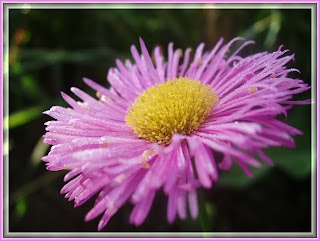Erigerons (soft "g") are a group of plants, mainly North American, that grow in sunny, open places. There are a large number of species, but I'm mainly interested in the garden perennials. Their flowers resemble those of asters, but they open at midsummer, making them long-day flowers. The dried plant was supposed to repel fleas, thus the common name, fleabane. The Latin name actually derives from Greek, eri - early, and geron - old man (as in gerontology). This was probably suggested by the white hairs that surround the seedheads.
According to Val Bourne, erigerons were popular about 50 years ago, but they're definitely out of fashion now. She claims that people found them too much trouble, and short-lived, but I never had any problems with mine. Still, if you read down through her article, you'll notice that the introduction dates for a lot of the plants she mentions are around the 1950s, although there are some German introductions from the early 1970s.
I’m
not sure I would have bothered much about them, except that I inherited one when I
bought a house. I was really impressed by it when it started to flower, putting
up its rayed daisies, petals several rows deep, with big yellow centres. It
took me a few tries to identify it, and I still don’t know what variety,
although I suspect it’s 'Pink Jewel'. It flowered for about a month, after which
the show was clearly over. (This may be just me; the RHS Encylopedia of Perennials says that if you cut them back they'll flower again in August. I may have been too far north.)
Still, it was definitely one of the best things about
June that year. Later I moved in a geranium ‘Patricia’ and an achillea ‘Liliac
Beauty’ next to it. The achillea was not the one I’d ordered, but I kept it because the
three plants looked so good together. (Next year I swapped the achillea for ‘Cerise
Queen’, the one I had wanted, and that looked good too.) I copied this picture of 'Pink Jewel' from the Far North Gardening Forum, but I couldn't find the owner:
 |
| Erigeron 'Rose Jewel' |
I should point out, in the name of accuracy, that since many of the best erigerons were bred in Germany, they tend to have German names. Strictly speaking, my plant was 'Rosa Juwel', I use the English form because that how you usually see it. But there are many others with the same name problem: 'Sommerneuschnee' or 'New Summer Snow'; 'Dunkelste Aller', or 'Darkest of All'; and 'Rotes Meer' or 'Red Sea'.
'Dunkelste Aller' also is slightly misleading, since it's been beaten by 'Schwarzes Meer' or Black Sea, bred in 1970. Still, both have lovely violet flowers, and would look fine in any border themed around Impure Blue, as this photo from Hortopedia shows:
 |
| 'Dunkelste Aller': Not the Darkest of them All? |
Apart from the German varieties, there are older ones bred by Allan Bloom, an Englishman who worked with many different perennials. You always know one of his because their names all end in "ity". Alan Bloom and his propagator Percy Piper experimented with creating a longer-lived, improved erigeron, and finally selected 11 plants which seemed tougher and better than the rest.
Of these, only one, "Dignity", has an AGM, or Award of Garden Merit. There are five others out there, but they're hard to come by. While 'Dignity' is violet-blue, 'Gaiety', 'Unity' and 'Felicity' are all pink, and 'Dimity' is a smaller, also pink, variety.
Of these, only one, "Dignity", has an AGM, or Award of Garden Merit. There are five others out there, but they're hard to come by. While 'Dignity' is violet-blue, 'Gaiety', 'Unity' and 'Felicity' are all pink, and 'Dimity' is a smaller, also pink, variety.
Another one worth mentioning is 'Quakeress', named because its colour, lavender-white, was supposed to be the colour of a Quaker's dress. It's an older, taller variety and worth having for the curiosity value alone, but it's supposed to be a good plant as well, with a long flowering season.
As well as having flowers like asters, erigerons come in much the same colours. Like asters, they need other, structural plants near them like achilleas, salvias, and sedums. Blue fescue is another idea. The bluer ones would be good near old roses, the ones that bloom in June-July and then are over. My old rosa gallica was like that, and a few of the pale violet erigerons would have looked amazing with it.
One final note: erigerons also grow like asters, only shorter. so a little discreet staking is probably required. I used to put hoops around them early on and tuck in any escapee stems later.



No comments:
Post a Comment